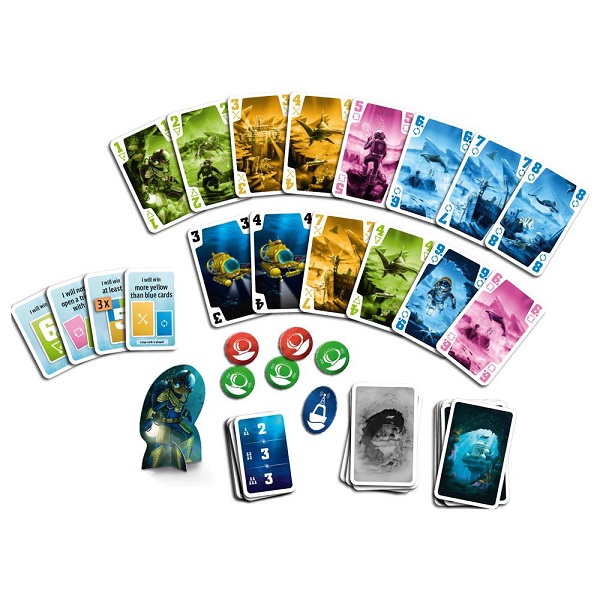Embark on Another Cooperative Adventure in The Crew: Mission Deep Sea

The sequel to The Crew: The Quest for Planet Nine, published by KOSMOS, Mission Deep Sea follows in the footsteps of its predecessor while bringing some new ideas to the table.
A cooperative trick-taking game, The Crew: Mission Deep Sea has you playing across thirty-two missions, as you search for Mu, a fabled lost land that is deep under the ocean.
Gameplay
The game is divided into thirty-two missions. Players can choose to either play through the missions in order or to jump around. At the start of a mission, you shuffle all the number cards and deal them out as evenly as possible to all players. Number cards come in four different colors or suits; with numbers one through nine in each suit, plus an additional submarine suit that only has cards one through four.
You read out loud the story for the mission you are playing and the win conditions. Typically, a mission will have you deal out task cards and then assign them in certain ways. When this is the case, the mission will list a difficulty number, such as four or ten. On the back of each task card, a difficulty value is listed based on the player count. You draw task cards until the combined difficulty level equals the mission’s difficulty. The tasks are then assigned based on the rules listed in the mission. The most common method is for players to take turns selecting a task. But sometimes a mission may allow players to divvy them up freely or force a single player to take them all. Players are not allowed to talk about their cards during the game.
To complete a task, you must complete the goal on the card. Task cards come in a wide range and can include things such as winning a certain card in a trick, winning no cards of certain colors, never winning two tricks in a row, or winning a trick that only contains odd-numbered cards, just to name a few.
Once tasks are assigned, or the win condition has been explained, the game starts with the player with the submarine card with a value of four. He starts the round by playing any one card. When a card is played, other players must follow suit if able. The high card of the matching suit wins the trick. Submarine cards act as trumps. Whoever wins the trick leads off the next one. If you complete one of your tasks, you turn it face-down.
For most missions, players have a sonar token. Before a new trick begins, you may use this token to place one of your cards (but never a submarine card) face-up in front of yourself and indicate if this card is your highest, lowest, or only card in your hand in its respective suit. Some missions, however, forbid you to use your sonar token.
Players can also choose to use the communication token at the start of each mission. This allows each of you to pass one card to the player on your left or right (players must agree on which direction they will be passing in) before they start the first trick.
If all players complete their tasks, they win the mission. If you fail the mission, you must start over, dealing out new hands to all players and choosing whether to try the same tasks again or deal out new ones. Some missions also have time limits, in which case you must complete your tasks before the timer runs out. Players can track in the mission booklet how many tries each mission took and if they used the communication token.

Review
The Crew: The Quest for Planet Nine was a clever and unique game that was accessible and innovative. Mission Deep Sea builds on the predecessor. The core gameplay is much the same, while the new range of mission cards brings more variety and allows for less repetitive missions.
The range in the missions is a lot of fun and some of them are quite creative. The additional mission types, such as the time limits or some that play around with different ways the sonar works, is also a clever twist.
This increase in variety, however, does make the game a little less simple to teach, and does complicate the setup a little bit more. The difficulty rating for each task is a great way to balance the game across all player counts but does increase setup time. Some tasks can also flatly contradict each other. The rulebook does explain what to do in these circumstances, but it just adds a little bit of extra work to get the game ready to start.
If you enjoyed the first Crew, then Mission Deep Sea is sure to be a hit. It brings enough new ideas to the table while still being the game you loved. While the original is a better place to start if you looking for something to play with family and friends who have less gaming experience, this is a great sequel that doesn’t disappoint.
Pros: More variety across missions, more balance for range of player count, more of what made the first game great
Cons: Setup is a little more complicated, slightly more rules to teach than in the first game
Disclosure: we received a complimentary review copy of this game.







